Article
Martin Luther IV: Adjusting to Life in Wittenberg
Author(s):
More than any city in Germany's Luther Country, Wittenberg is where you get a true sense of Martin Luther, the man - and his life. Germany's Luther Country Festival, celebrating the life of the father of the Reformation, goes on till 2017.
Photography by the authors
More than any city in Luther Country, Wittenberg is where you get a true sense of Martin Luther, the man — and his life. He came here first as a student in 1508, returned as a monk in 1511 and became a professor of bible studies in 1512. He posted his protests about “indulgencies” on the door of the Castle Church here in 1517 — a date that will be celebrated at the conclusion of the 500 Years of History in 2017.
Luther spent May 1521 to March 1522 in Castle Warburg then returned to Wittenberg. Here he would live for the next 24 years except for the short time before his death in Eisleben in February 1546.
It’s a mere 15-minute drag from the railway station to the luggage locker rooms in the former Augustinian monastery in town, now the Luther House, the world’s largest museum on Reformation history.

Although the museum has many rooms showing the Luther story, including the large hall where he would lecture to as many as 400 students at a time, it also gives a sense of how the Luther family lived. Because there was a family!
As Luther, the prior priest, shook off his Catholic robes and his very Catholic identity, he found himself more and more in the company of the former nun Katharina von Bora. They married in 1525.
“I would not want to exchange my Kathe for France not for Venice to boot,” he would say in 1531.
No wonder! After the Reformation when the Augustinian monks left (and the building was used by Luther, his wife and groups of university students), she was the practical one who managed their finances. She planned the vegetable garden, fed the students and was the one who collected the rent!
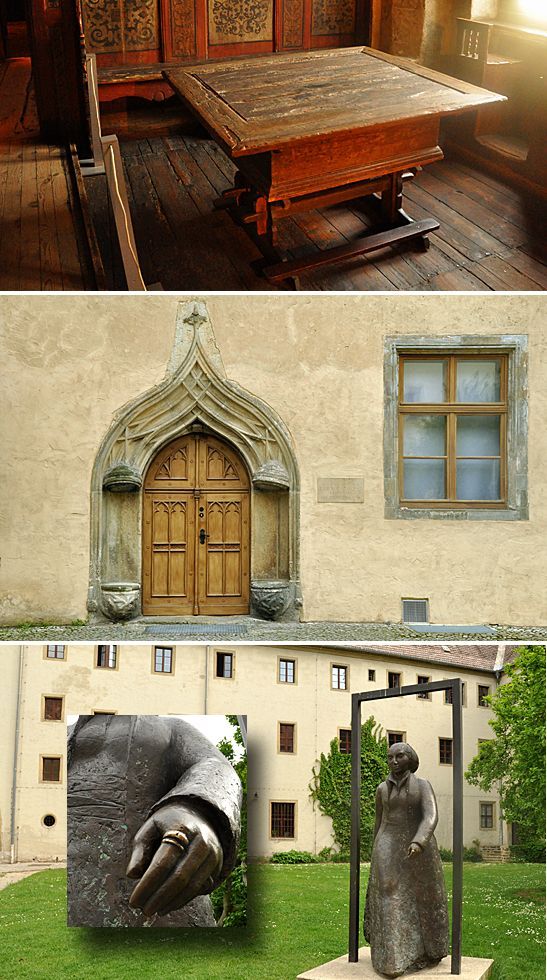
Table Talks
Over the centuries many left their autographs, the most famous being that of Peter the Great, the Czar of Russia. Upstairs is a famous painting of the Ten Commandments by Louis Cranach, the Elder, a contemporary artist and close friend of Luther’s. Perhaps the most important piece of original furniture in the Luther House is the solid table in the living room where he sat with the students, sometimes getting their reaction to talks and sermons he was working on. He published details in 1531 in his book called .
The outside door — added to the building when its ownership was passed to Luther by his patron, the Elector Frederick the Wise — was Katrina’s birthday present to her husband in 1540. Her statue stands in the grounds of this historic building.

Collegienstrasse
The main street up to the Castle Church, , reminds visitors that the city’s university was one of the most illustrious in the Middle Ages. William Shakespeare had Hamlet and his friend Horatio attending it! The college was funded in 1502 by this nobleman whose name keeps coming up, Frederick III the Wise.
“It was the first university not supervised by the Catholic Church,” our guide tells us. “At that time the population was 2,000. Now it is 46,000.”
We walk past names famous to Germans. Johann Andreas Eisenbarth, for example, was a traveling barber-surgeon whose orthopedic skills possibly exceeded those of more qualified physicians. He also “cut for stone.”
Michael Stifel was a monk who wrote a favorable poem about Luther, but then as a mathematician — he was the first to create and use what were early forms of logarithms — he predicted the world would end at 8 a.m. on Oct. 19, 1533. As pastor of a local church he felt obliged to warn his congregation. Many sold their homes, gave away their money and waited outside the church for the end. It never came. He was arrested and jailed while, outside, outraged parishioners chanted a song that became famous, “Stifel should die!” He was removed from his church duties. Those who wonder why and how he came to the calculations that the world would end can click here.
Abraham Vater was the Professor of Anatomy at the University — an anatomist and a philosopher (surely an interesting combination). He was the first to describe the hepato-pancreatic ampulla now known as the Ampulla of Vater.
The walk takes visitors past the homes and courtyard of the Cranach family, one of the wealthiest in town. He was a famous and successful artist, landowner, printer and apothecary owner. A friend of Luther’s, he was pleased to give Katrina Luther, a nun who knew her background in science, a position in his store as a herbalist.
hodie mihi, cras tibi
The street passes a former medieval hospital where a stone carving at the entrance shows a figure with eyes closed clutching a skull and the inscription over the entrance that reads , which refers to death and translates from Latin as ”My turn today and yours tomorrow.” Those doctors of the Middle Ages didn’t have much of a bedside manner.
nailed
The street leads to the church where Luther famously (although that story is disputed by some) his 95 Theses in 1517.
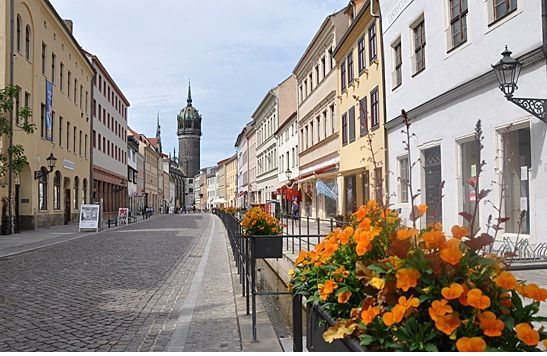

The Castle tower shows where we are heading, but fires during wars in 1760 and 1815 sent most of the church up in flames, including its wooden doors. A black bronze door was erected in 1858 inlaid with the Latin versions of Luther’s Theses.
The church interior is somewhat intimidating, but that is possibly its intent. A Luther statue stands inside as do figures of armed bishop-princes or contemporary Crusaders presumably ready to fight for God. They might dissuade any person preparing to challenge Rome — any person except perhaps Luther.
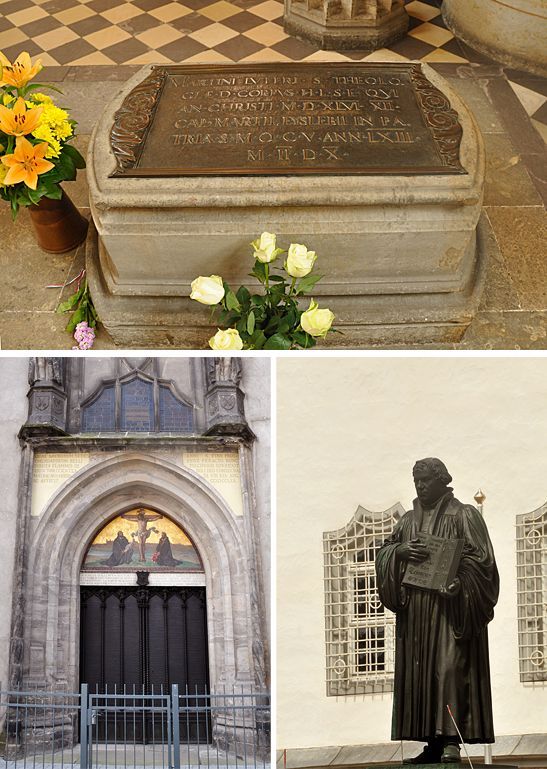
Luther died in 1546 in Eisleben, the town where he was born, but he is buried in the Castle Church here. A gate stands in front of the famous church door and another statue of the father of the Reformation stands in the Town Square around the corner from the church where he preached: the Town and Parish Church of St. Mary. That church still has in use the baptismal font in which he baptized his and Katrina’s six children.
“Three were girls and three boys,” our guide says. “Two of the girls died young; the third we know was a ‘good wife.’ One boy became a lawyer, another a professor of medicine at the university. The last boy was a ‘black sheep.’”

original
We had seen in the Luther House museum, a unique exhibit no other museum has: the pulpit basket from the town church where from 1514 onwards Luther delivered most of his sermons (of which more than 2,000 exist). The two panels visible show “the evangelist Matthew in his study to the left and the evangelist John to the right.”
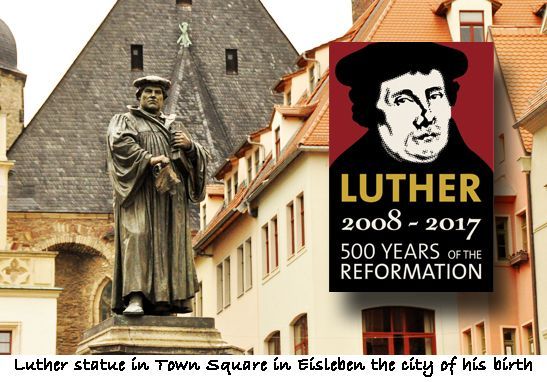
As we take our farewell from our German guide he says proudly, “Tell your readers that the Luther Country Festival goes on till 2017. If they come they will find, though Luther lived five centuries ago, his presence is still tangible in Germany. You can literally walk in his footsteps. You can examine the notes he wrote on the pages of his Bible, photograph the table where he ate and worked, admire the pulpit where he preached — and where pastors still preach today — and step into the very room where he translated the New Testament. Hey, you can even eat the type of sausage he enjoyed and taste beer brewed the way he liked it. We are indeed in Luther Country!”
Money talk
It is difficult to say whether prices will increase as the last year of the Luther Country Festival gets closer. At the moment central Germany is much more reasonable than popular tourist areas in, say, Copenhagen, Vienna or Venice.
The towns that Luther touched are fairly close together and easily reached on intercity or national rail. This proximity makes a Germany Rail Europe pass a great investment — but do your research because an occasional intercity train trip purchased locally as a “point to point” day ticket may get around the need to buy so many days with your Rail Europe pass.
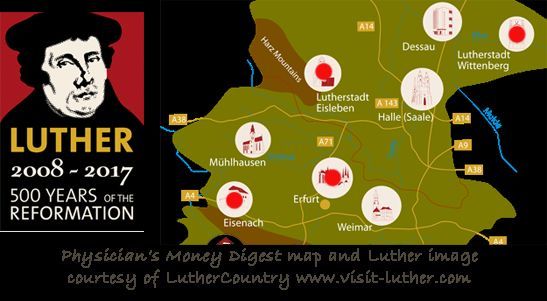
You don’t need to stay the night in every Luther town. The map we used in the first Luther article shows with red dots the four towns we visited. Erfurt, the capital of Thuringia, would be a convenient central lodging with interesting attractions beyond Luther.
group
There’s also a lot to see in Wittenberg but it’s not as central as Erfurt. Tourist-Information Lutherstadt Wittenberg has, at the moment, interesting package deals, where a group of 20 can get tours “In the Footsteps of Luther” if 20 visitors buy 10 rooms for the price of 65 euros per person including breakfast. Check the website for details and the other Luther towns, too. The dollar is now stronger against the Euro.
One of our guides told us they were hoping those fascinated by the life of Martin Luther were interested from the point of medieval history not because they were religious zealots.
“Germany used to be comfortably Protestant and did not need to blow trumpets to show it,” he said. “But now church attendance is significantly down in both Protestant and Catholic churches and many cities have non-religious majorities.”
The Man Who Cried Orange: Stories from a Doctor's Life.
The Andersons, who live in San Diego, are the resident travel & cruise columnists for Physician's Money Digest. Nancy is a former nursing educator, Eric a retired MD. The one-time president of the NH Academy of Family Practice, Eric is the only physician in the Society of American Travel Writers. He has also written five books, the last called




